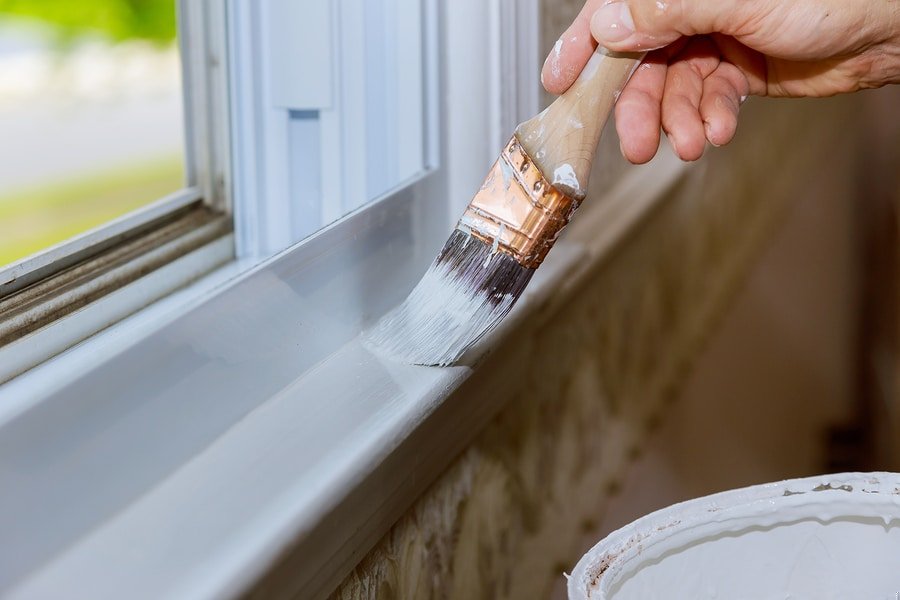Yes, you can paint UPVC windows, but it requires the right approach and materials. Many homeowners want to refresh the look of their property without the hefty cost of replacements. Painting UPVC can breathe new life into your home’s exterior and let you express your style.
However, not all paints will adhere well to UPVC, so it’s crucial to choose a suitable product designed for plastic. With the right preparation and technique, you’ll end up with a beautiful finish that lasts. Ready to give your UPVC windows a makeover? Let’s dive into the details!
Can You Paint uPVC Windows?
When it comes to home improvement, many homeowners wonder, “Can you paint uPVC windows?” The answer is yes, you can! However, painting uPVC windows involves careful preparation and the right materials. In this article, we will explore the ins and outs of painting uPVC windows, discussing the benefits, necessary materials, step-by-step processes, and tips to achieve a flawless finish. By the end of this guide, you will be equipped with all the information you need to decide whether to paint your uPVC windows and how to do it effectively.
Understanding uPVC Windows
Before diving into the painting process, let’s take a moment to understand what uPVC windows are and why they are popular.
What is uPVC?
– **uPVC stands for Unplasticized Polyvinyl Chloride**. It’s a type of plastic that is widely used in the construction of windows and doors.
– uPVC is known for being strong, durable, and resistant to weathering. Unlike wood, it doesn’t warp or rot, making it a popular choice for homeowners.
Why Choose uPVC Windows?
– **Low Maintenance**: They require minimal upkeep compared to wooden windows.
– **Energy Efficiency**: uPVC windows help in retaining heat, keeping your home warm.
– **Cost-Effective**: They are generally more affordable than wood or aluminum alternatives.
The Popularity of uPVC Windows
Since their introduction, uPVC windows have gained immense popularity. However, their standard white color can sometimes feel bland. Painting uPVC windows allows homeowners to customize their look and enhance their home’s curb appeal.
Reasons to Paint uPVC Windows
Now that we understand what uPVC windows are, let’s explore why you might consider painting them.
Enhance Aesthetic Appeal
– Painting your uPVC windows allows you to match your home’s exterior or experiment with different colors.
– It can make your home feel more inviting and personal.
Increase Property Value
– A fresh coat of paint can make windows look new, thereby increasing the overall value of your property.
– Well-maintained windows can be a selling point if you ever decide to sell your home.
Protect the Material
– Quality paint can provide an extra layer of protection against UV rays and weather damage.
– This protection can help prolong the life of your uPVC windows.
Preparation: Getting Ready to Paint
Proper preparation is essential for achieving a successful paint job on uPVC windows. Here’s how to prepare:
Necessary Materials
Before you start, gather the following materials:
– **High-quality exterior paint** formulated for plastic
– **Primer** specifically designed for uPVC
– **Sandpaper** (fine grit)
– **Clean cloths or rags**
– **Masking tape**
– **Paintbrush and roller**
– **Paint tray**
– **Protective gloves and eyewear**
Steps for Preparation
1. **Clean the Surface**:
– Use soapy water to wash the windows thoroughly, removing any dirt or grime. Rinse well and let them dry completely.
2. **Sand the Surface**:
– Lightly sand the uPVC using fine-grit sandpaper. This step helps the primer and paint adhere better.
– Be careful not to sand too aggressively; you only want to create a rough surface.
3. **Mask Off Areas**:
– Use masking tape to protect areas around the windows that you don’t want to paint, such as walls or glass panes.
Choosing the Right Paint and Primer
Selecting the right products is critical for a long-lasting finish.
Types of Paint
– **Acrylic Paint**: A top choice for uPVC due to its flexibility and durability.
– **Specialized uPVC Paint**: Some brands offer paints specifically designed for plastic surfaces.
Types of Primer
– **Plastic Primer**: Always choose a primer that is formulated for uPVC to ensure proper adhesion.
Step-by-Step Painting Process
Now that you’ve prepared the surface and gathered your materials, it’s time to paint! Follow these steps for an effective painting process:
Applying Primer
1. **Stir the Primer**: Ensure the primer is mixed well before use.
2. **Apply the Primer**:
– Use a paintbrush for edges and a roller for larger areas.
– Apply an even coat and let it dry completely as per the manufacturer’s instructions.
Painting the uPVC Windows
1. **Stir the Paint**: Just like with the primer, ensure your paint is mixed thoroughly.
2. **Start Painting**:
– Use a brush for corners and detailed areas, and a roller for the broad surfaces.
– Apply a thin first coat, making sure not to overload your brush or roller.
3. **Let it Dry**: Allow the first coat to dry completely. Check the manufacturer’s recommended drying time.
4. **Apply Additional Coats**:
– Depending on the color and finish, you may need a second or even third coat for full coverage. Just make sure to read the labels for guidance.
Finishing Touches
– Once the final coat is dry, carefully remove any masking tape.
– Inspect for areas that may need touch-ups and apply as necessary.
Post-Painting Care
After painting your uPVC windows, follow these steps to keep them looking great:
Regular Cleaning
– Clean the painted surfaces with mild soap and water to remove any dirt and keep the color vibrant.
Avoid Harsh Chemicals
– Steer clear of abrasive cleaners or harsh solvents, as they can damage the paint.
Inspect for Damage
– Regularly check for any signs of wear and tear. Early repairs can prevent larger issues down the road.
Common Mistakes to Avoid
To ensure a successful painting experience, keep these common pitfalls in mind:
Skipping Preparation
– Failing to clean or sand the surface can lead to poor adhesion and paint peeling.
Using the Wrong Products
– Using interior paint or regular exterior paint on uPVC can result in a disappointing finish. Always choose products specifically designed for plastic surfaces.
Neglecting Weather Conditions
– Painting in extreme temperatures or high humidity can affect drying times and the final appearance. Aim for a dry day with mild temperatures.
Frequently Asked Questions About Painting uPVC Windows
While we won’t delve into a dedicated FAQ section here, some common questions often arise regarding the painting of uPVC windows. Homeowners frequently inquire about the lifespan of painted surfaces, the best types of paint to use, and how long the painting process takes. These considerations can play a vital role in your decision-making.
In summary, painting uPVC windows is not only possible but also a great way to enhance your home’s appearance. With the right preparation, tools, and techniques, you can achieve a beautiful and durable finish. Enjoy the process and the fresh look of your revamped windows—your home deserves it!
How to paint your uPVC Windows with a Brush on uPVC Paint
Frequently Asked Questions
“`html
What type of paint is suitable for UPVC windows?
When painting UPVC windows, it is important to use a paint specifically designed for plastic surfaces. Look for paints labeled as suitable for UPVC or plastic. Acrylic-based paints or specialized UPVC paint provide good adhesion and durability. Make sure to follow the manufacturer’s instructions for the best results.
How do I prepare UPVC windows before painting?
To prepare UPVC windows for painting, start by cleaning the surface thoroughly with soapy water to remove dirt and grime. Rinse well and allow them to dry completely. Next, lightly sand the surface with fine-grit sandpaper to create a texture that helps the paint adhere better. After sanding, wipe the windows again to remove any dust particles.
Is it necessary to prime UPVC windows before painting?
Using a primer on UPVC windows can enhance paint adhesion and durability, but it is not always necessary. If you choose a paint marketed for UPVC, it often contains adhesion promoters that may eliminate the need for a primer. However, applying a primer can provide an extra layer of protection, especially if the windows have not been painted before or if you are making a significant color change.
How long will the paint last on UPVC windows?
The longevity of paint on UPVC windows largely depends on the quality of the paint used and the application process. High-quality UPVC paint applied correctly can last from five to ten years. Regular maintenance, such as washing the windows periodically, can also help prolong the life of the paint finish.
Can I change the color of my UPVC windows?
Yes, you can change the color of your UPVC windows through painting. Many homeowners choose this option to match their style or improve curb appeal. Just ensure you follow proper preparation and application techniques for the best results. Always choose a color that maintains good harmony with your home’s exterior.
Are there any risks involved in painting UPVC windows?
Painting UPVC windows carries some risks, including potential peeling or chipping if the correct paints and methods are not used. Poor surface preparation or using incompatible paints can also lead to issues. Additionally, painted UPVC may require more maintenance compared to original finishes. It’s important to follow guidelines and choose quality materials to minimize these risks.
“`
Final Thoughts
Painting UPVC windows is possible and can significantly enhance their appearance. You need to prepare the surface properly by cleaning and using a suitable primer designed for plastic.
After priming, choose high-quality exterior paint that adheres well to UPVC.
In summary, yes, you can paint UPVC windows, but careful preparation and the right materials are essential for a successful and lasting finish.



